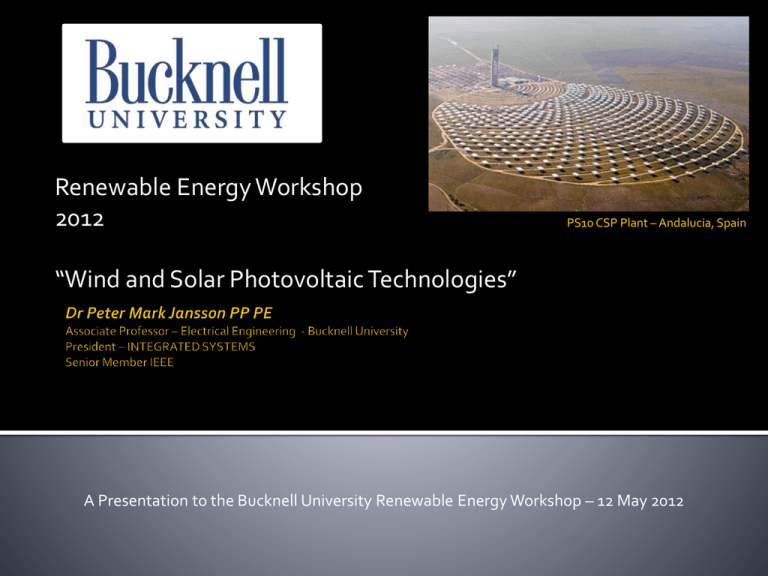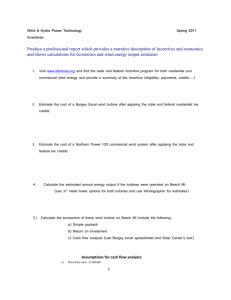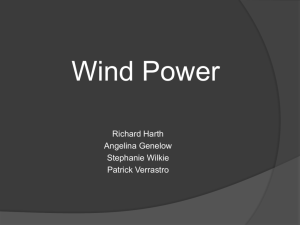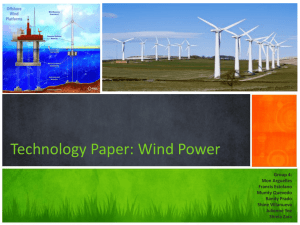Wind and Solar Photovoltaic Technologies
advertisement

Renewable Energy Workshop 2012 PS10 CSP Plant – Andalucia, Spain “Wind and Solar Photovoltaic Technologies” A Presentation to the Bucknell University Renewable Energy Workshop – 12 May 2012 The first known wind turbine for producing electricity was by Charles F. Brush turbine, in Cleveland, Ohio in 1888 • 12 kW • Used electricity to charge batteries in the cellar of the owner’s mansion Note the person http://www.windpower.org/en/pictures/brush.htm First wind turbine outside of the US to generate electricity was built by Poul la Cour in 1891 in Denmark • Used electricity from his wind turbines to electrolyze water to make hydrogen for the gas lights at the schoolhouse http://www.windpower.org/en/pictures/lacour.htm LaCour Test Turbines 1897 Schmidt 1942 Class of 1904 Schmidt 1942 Juul’s Gedser 200kW design 1957-1975 © Copyright 1997-2003 Danish Wind Industry Association Updated 23 July 2003 In the US - first wind-electric systems built in the late 1890’s By 1930s and 1940s, hundreds of thousands were in use in rural areas not yet served by the grid Interest in wind power declined as the utility grid expanded and as reliable, inexpensive electricity could be purchased Oil crisis in 1970s created a renewed interest in wind until US government stopped giving tax credits Renewed interest again since the 1990s Large (megawatt) machines Vestas 1.5MW 68m Nordex 2.5MW 100m © Copyright 1997-2003 Danish Wind Industry Association Updated 23 July 2003 Nordtank 1.5MW 64m Vattenfall owns many of the world’s largest offshore wind farms 300 MW Thanet Farm (100 -3MW turbines) 160 MW Horns Rev Farm (80-2MW units) 110 MW Lillegrund Farm (48-2.3 MW units) 90 MW Kentish Flats Farm (30-3MW units) In total Vattenfall provides the EU with ~2TWh of wind energy annually from over 500 large scale wind turbines Current plans are for 6,000 MW in a partnership with Scottish Power Renewables © Copyright 2010 – Vattenfall Thanet 300MW “Thanet” located off British coast in English Channel 100 Vestas V90 turbines, 300 MW capacity Turbines are located in water depth of 20-25m. Rows are 800m apart; 500m between turbines http://edition.cnn.com/2010/WORLD/europe/09/23/uk.largest.wind.farm/?hpt=Sbin http://www.vattenfall.co.uk/en/thanet-offshore-wind-farm.htm Offshore wind turbines currently need to be in relatively shallow water, so maximum distance from shore depends on the seabed Capacity factors tend to increase as turbines move further off-shore Image Source: National Renewable Energy Laboratory http://www.windpoweringamerica.gov/pdfs/wind_maps/us_windmap.pdf http://www.windpower.org/en/pictures/lacour.ht Source: www.ceoe.udel.edu/WindPower/ResourceMap/index-world.html Why V3 ? AV m 1 3 Ptot AV 2 Pw C p Ptot m r V What does plot look like? China 62,733 United States 46,919 Germany 29,060 Spain 21,674 India 16,084 France 6,800 Italy 6,747 United Kingdom 6,540 Canada 5,265 Portugal 4,083 Rest of world 32,444 Top 5 States with Wind Power Capacity Installed, 2010: 1. Texas 2. Iowa 3. California 4. Minnesota 5. Washington 10,135 MW 3,675 MW 3,179 MW 2,432 MW 2,356 MW SOURCE: AWEA Last updated: 8.4.2011 VAWT HAWT downwind HAWT upwind SOURCE: http://www1.eere.energy.gov/wind/wind_how.html#inside 1 3 Pw Av 2 3 1.225kg / m (1atm.,15C ) Wind Maps NREL Wind Models Based Upon Maps/Data New Jersey has Interactive Map Site Data Anemometer Loan Programs Adjacent NWS sites v H vo H o v ln( H / z ) vo ln( H o / z ) Tables 6.3 & 6.4, Page 320 Max theoretical is called Betz efficiency For typical turbines this is 59% Under ideal conditions today’s turbines can achieve 80% of the max theoretical: So many turbines range between 45-50% Start by Analyzing your Wind Map Determine potential generation Determine local costs of electricity Base your estimates on a real wind generator power curve (Bergey, etc.) Complete Cost Benefit Analysis Solar Intensity: Atmospheric Effects Sun photosphere Intensity Extraterestrial sunlight (AM0) Sunlight at sea level at 40° N Lattitude at noon (AM1.5) “AM” means “air mass” Figure 7.5 For solar energy applications, we’ll consider the characteristics of the earth’s orbit to be unchanging Solar noon – sun is directly over the local line of longitude Rule of thumb for the Northern Hemisphere - a south facing collector tilted at an angle equal to the local latitude • Figure 7.8 During solar noon, the sun’s rays are perpendicular to the collector face Altitude Angle Azimuth Angle Figure 7.10 Trees to the southeast, small building to the southwest Can estimate the amount of energy lost to shading Figure 7.15 http://mapserve3.nrel.gov/PVWatts_Viewer/index.html Fig. 3-12 PV cell characteristics [11]. © Copyright Ned Mohan 2006 Incoming Photons Top Electrical Contacts electrons - - - - Accumulated Negative Charges - - - - n-type Holes E-Field + - p-type + - + - + - + - + - + - + - + - Depletion Region Electrons + + + Accumulated Positive Charges + + + Bottom Electrical Contact I SOURCE: California Energy Commission - Guide to PV System Design and Installation – June 2001 [Available Online] : http://www.energy.ca.gov/reports/2001-09-04_500-01-020.PDF www.solarpathfinder.com PathFinder, Tripod and Software http://www.solarpathfinder.com/ord/configure?id=rWISgKdJ&mv_arg=PF http://www.civicsolar.com/product/solmetricsun-eye-210 Fixed Panel facing south at 40o N latitude 40o tilt angle: 2410 kWh/m2 20o tilt angle: 2352 kWh/m2 (2.4% loss) 60o tilt angle: 2208 kWh/m2 (8.4% loss) Fixed panel facing SE or SW (azimuth) 40o tilt angle: 2216 kWh/m2 (8.0% loss) 20o tilt angle: 2231 kWh/m2 (7.4% loss) 60o tilt angle: 1997 kWh/m2 (17.1% loss) Williamsport, PA 1-kW 30o tilt example 1,115 kWh/year Single axis – 1,361 kWh/year 22% improvement at 41o N latitude Two axis tracking – 1,415 kWh/m2 27% improvement at 41o N latitude





